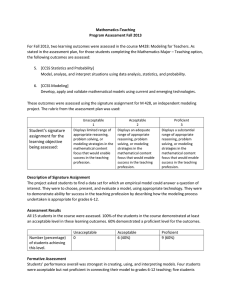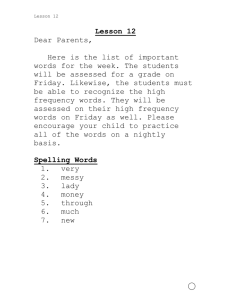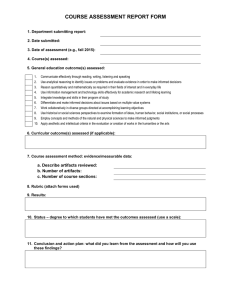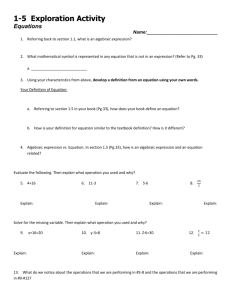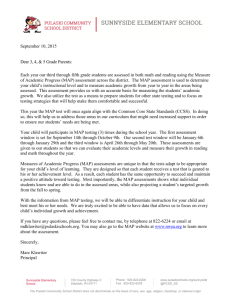For the Fall of 2012, two learning outcomes were assessed... . As stated in the assessment plan, by completing the...
advertisement
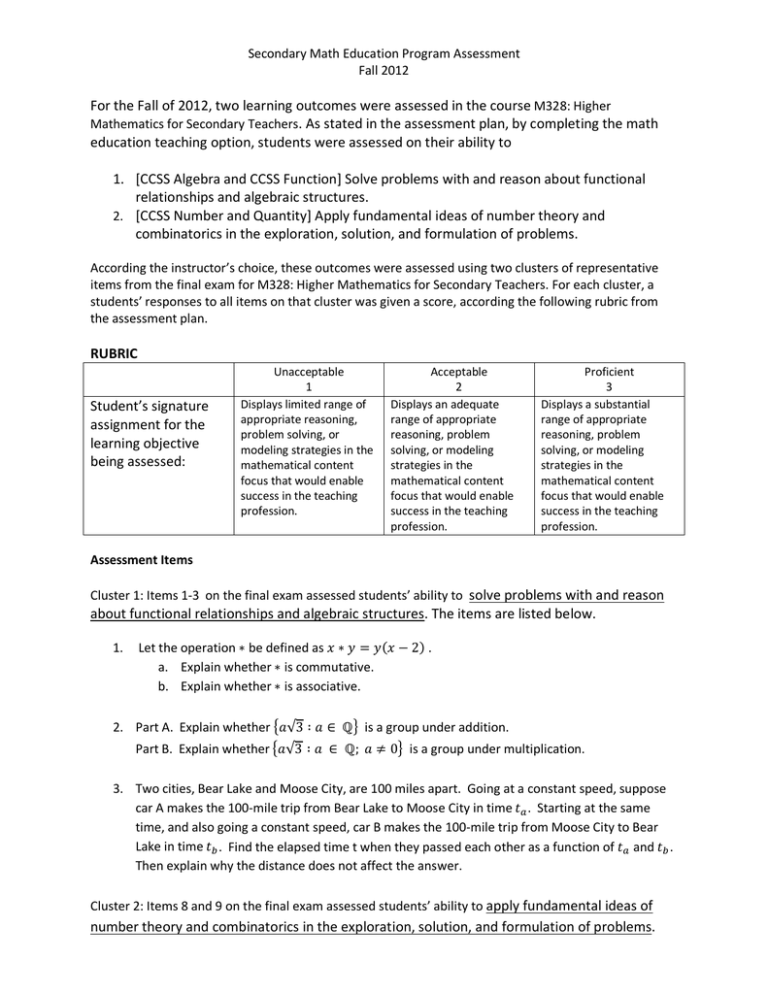
Secondary Math Education Program Assessment Fall 2012 For the Fall of 2012, two learning outcomes were assessed in the course M328: Higher Mathematics for Secondary Teachers. As stated in the assessment plan, by completing the math education teaching option, students were assessed on their ability to 1. [CCSS Algebra and CCSS Function] Solve problems with and reason about functional relationships and algebraic structures. 2. [CCSS Number and Quantity] Apply fundamental ideas of number theory and combinatorics in the exploration, solution, and formulation of problems. According the instructor’s choice, these outcomes were assessed using two clusters of representative items from the final exam for M328: Higher Mathematics for Secondary Teachers. For each cluster, a students’ responses to all items on that cluster was given a score, according the following rubric from the assessment plan. RUBRIC Student’s signature assignment for the learning objective being assessed: Unacceptable 1 Displays limited range of appropriate reasoning, problem solving, or modeling strategies in the mathematical content focus that would enable success in the teaching profession. Acceptable 2 Displays an adequate range of appropriate reasoning, problem solving, or modeling strategies in the mathematical content focus that would enable success in the teaching profession. Proficient 3 Displays a substantial range of appropriate reasoning, problem solving, or modeling strategies in the mathematical content focus that would enable success in the teaching profession. Assessment Items Cluster 1: Items 1-3 on the final exam assessed students’ ability to solve problems with and reason about functional relationships and algebraic structures. The items are listed below. 1. Let the operation ∗ be defined as 𝑥 ∗ 𝑦 = 𝑦(𝑥 − 2) . a. Explain whether ∗ is commutative. b. Explain whether ∗ is associative. 2. Part A. Explain whether �𝑎√3 ∶ 𝑎 ∈ ℚ� is a group under addition. Part B. Explain whether �𝑎√3 ∶ 𝑎 ∈ ℚ; 𝑎 ≠ 0� is a group under multiplication. 3. Two cities, Bear Lake and Moose City, are 100 miles apart. Going at a constant speed, suppose car A makes the 100-mile trip from Bear Lake to Moose City in time 𝑡𝑎 . Starting at the same time, and also going a constant speed, car B makes the 100-mile trip from Moose City to Bear Lake in time 𝑡𝑏 . Find the elapsed time t when they passed each other as a function of 𝑡𝑎 and 𝑡𝑏 . Then explain why the distance does not affect the answer. Cluster 2: Items 8 and 9 on the final exam assessed students’ ability to apply fundamental ideas of number theory and combinatorics in the exploration, solution, and formulation of problems. Secondary Math Education Program Assessment Fall 2012 8. Some children and their parents are sitting on a long park bench at a park. There are four children, and one parent per child, so eight people total. How many ways are there for them to sit if a. anyone may sit in any place b. on both ends there are parents seated c. each child must be seated by their parent 9. Suppose that 5 freshmen, 4 sophomores, and 7 juniors have been nominated to receive scholarships of $500, $250, and $100. How many different distributions of the three scholarships are possible under the following circumstances? a. Anyone may receive any scholarship. b. At least two scholarships are awarded to juniors. c. A freshman receives at least one scholarship. d. One scholarship is awarded to someone from each class. Results Learning Outcome 1: 100% of the students in the course demonstrated an acceptable ability level in solving problems with and reasoning about functional relationships and algebraic structures. 87% of the students demonstrated a proficient ability level in solving problems with and reasoning about functional relationships and algebraic structures. Learning Outcome 2: 100% of the students in the course demonstrated an acceptable ability level in applying fundamental ideas of number theory and combinatorics in the exploration, solution, and formulation of problems. 93% of the students in the course demonstrated a proficient ability level in applying fundamental ideas of number theory and combinatorics in the exploration, solution, and formulation of problems. Thus, the secondary math education program at Montana State has successfully met the criteria set forth in the program assessment plan for Fall of 2012.
